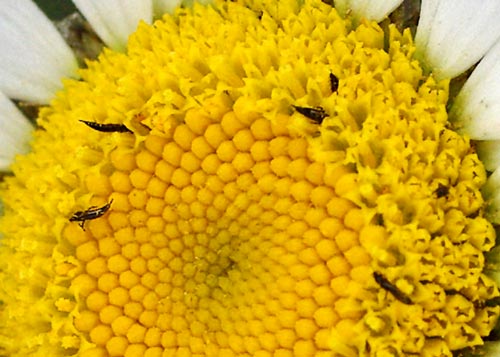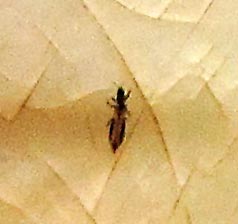Salutations, BugFans,
If the BugLady were a betting woman, she’d wager that every gardening organization, exterminator’s site/shop, and state and county Extension office has at least one Thrips Fact Sheet. There is a mountain of information available about thrips, so here’s Thrips 101.
Cool Thrips Fact No. 1
If you see 27 thrips, you say “I see 27 thrips.” If you only see one (an impossibility, according to some people), you say “I see one thrips.” Singular is plural is singular. Like sheep, fish, grouse, moose and deer.
Thrips belong in the insect order Thysanoptera, which means “fringed wings,” though the BugLady will have to take the experts’ word on that score. Thrips are tiny—flea-sized (fleas are flattened laterally—as if you clapped your hands with a flea inside—and thrips are flattened the other way, like you whacked one that was sitting on the table). That flatness allows them to squeeze into tight spots like the spaces between buds in a daisy. Thrips are divided into sub-orders based on the shape of their last abdominal segment and on the presence/absence of an ovipositor, and thrips family affiliation depends on the characteristics of their antennae.
Some alternate names (names that can be printed in this (mostly) family-friendly series) are corn lice, storm flies, thunderflies and thunderbugs. The word thrips comes from a Greek word that means wood louse or wood worm.
Cool Thrips Fact No. 2
The “Thunderbug” is the mascot of the Tampa Bay Lightning professional hockey team. But, their mascot seems to be a giant lightning bug, not a giant thrips, so Thunderbug must translate differently in Floridian.
Adult thrips come in a variety of colors from yellowish-white to black (most nymphs are cream-colored), and some predatory thrips have red-orange abdomens. Some thrips are winged and others are not, and if wings are present, they are held flat across the back. Thrips have both compound and simple eyes and short antennae. And they are tiny—many are 1 to 2 mm long, and others are smaller (one source suggests unnecessarily that “Magnification is required for best identification”).
North America boasts some 700 of the 5,000 to 6,000 species of thrips described thus far, and about 100 species inhabit the Great Lakes area. Thrips enter the fossil record in Permian times (about 250 million years ago), but it took them another 100 million years to become abundant. Where can you find them? Where plants or fungi grow.
Cool Thrips Fact No. 3
Thrips have asymmetrical, rasping-sucking mouthparts. The mandible on the right side is reduced/vestigial, and the mandible on the left is modified into a sword/stylet that allows a thrips to first rasp a plant part and then suck the juices that weep out (some species inject a solvent to get things flowing). Kaufman and Eaton, in their terrific Field Guide to Insects of North America, call the feeding style “punch and suck.” It is their dining habits that get thrips in trouble.
If you’re a plant, there’s a thrips that loves you. Many species eat fungi, others have catholic tastes in higher plants, and still others are picky eaters. They rasp and suck, often along the plants’ main veins, causing leaves or buds to become spotted, discolored, scarred, deformed, folded, blistered and/or rolled. There are thrips that eat the spores of fungi and others that ingest pollen or chloroplasts. Predatory thrips feed on very (very) small invertebrates. There are reports of thrips biting humans, but experts assure us that these thrips are just checking to see if we might be plants (a small stab of pain is involved, but no venom, and some people itch or get a rash). Along with the cosmetic damage and decreased crop yields they leave in their wake, thrips also deposit frass (bug poop) on leaves and flowers, and they are guilty of transmitting viruses from plant to plant. On the plus side, they are considered pollinators.
What eats thrips? A few ladybugs and mites, green lacewings, and some small parasitic wasps that place their egg in/on the thrips.
Cool Thrips Fact No. 4
Thrips can climb up vertical surfaces. At the end of each tiny tarsus (foot) are bladder-tipped claws that can be inflated by changes in the pressure of the hemolymph (the invertebrate equivalent of blood and lymph), allowing thrips to cling.
Where do little thrips come from? Depending on whether she has a formal ovipositor or not, Ms. Thrips lays eggs in plant tissues or on vegetation or in crevices or in a gall formed for the occasion. If it has been inserted into a plant, the egg “squeezes out” of the plant just before hatching (Thrips Magic). There are records of maternal guarding and cleaning of eggs (to remove harmful microbes) and of paternal guarding of the care-giving females.
Thrips have Simple Metamorphosis—sort of. The young do hatch out looking like even tinier, wingless adults, but they’re called larvae, not nymphs. They do feed and molt (twice), but then they stop eating and enter the soil for a “pre-pupal” stage. Afterward there is a “pupal” resting stage (some even make a cocoon), but it’s not a true pupal stage in which the tissues are disassembled and reconfigured into an adult organism that looks fundamentally different. Depending on available food and weather, a thrips may go from egg to egg-layer in two or three weeks.
Sex? Yes. or No. Thrips’ reproduction can be sexual (involving two consenting thrips) or asexual (involving parthenogenesis—virgin birth). When it does happen, copulation can last for hours (scientists will put a stopwatch to anything). Thrips practice arrhenotokous parthenogenesis, which produces male offspring (as opposed to the less-common theotokous—female-producing—parthenogenesis) (the BugLady just knew that BugFans wanted to start the year by chewing on some tasty vocabulary words). Female thrips are larger than males. When winter comes here in God’s Country, adult and immature thrips head for shelter in/under vegetation and debris; in warmer climes they remain active all year and may produce a dozen generations.
Cool Thrips Fact No. 5
OK, a little more heavy lifting here. In a page ripped from science fiction shows, endosymbiont bacteria that answer to the name Wolbachia may determine the gender of some species of thrips. These widespread bacteria, which are found in lots of insects and other arthropods, “favor” females. The bacteria may be directly lethal to males in eggs; may cause males to develop as pseudo-females; may allow infected females to reproduce solo; or may prevent infected males from reproducing successfully by making them incompatible with females on a cellular level. Some scientists say that Wolbachia explains parthenogenesis.
Thunderbugs? For a nearly microscopic organism, thrips get around very well on their own six feet, and the winged species are competent flyers. Once they are airborne the wind does the rest, moving them unimaginable distances. Because they often decide to fly during thunderstorms (which seems counterintuitive, considering the damage a single descending raindrop could do to a thrips), they have picked up names like thunderbug or thunderfly. They also disperse nestled in nursery stock, transported around the world. Thrips may occur in huge swarms, causing, as one source put it, “entomophobia.”
Cool Thrips Fact No. 6
Some thrips have a chemical defense against predators. When poked or prodded, these thrips raise their abdomens and release a tiny drop of smelly liquid produced in the hindgut. The chemical contains a known ant-repellent that may also function as an irritant, a fumigant, and an alarm pheromone to warn other thrips in the neighborhood.
It’s possible that the thrips pictured here are Composite Thrips (Microcephalothrips abdominalis), which specialize in flowers in the Aster/Composite family.
You’re right, Ritz—thrips are cool!
The BugLady

